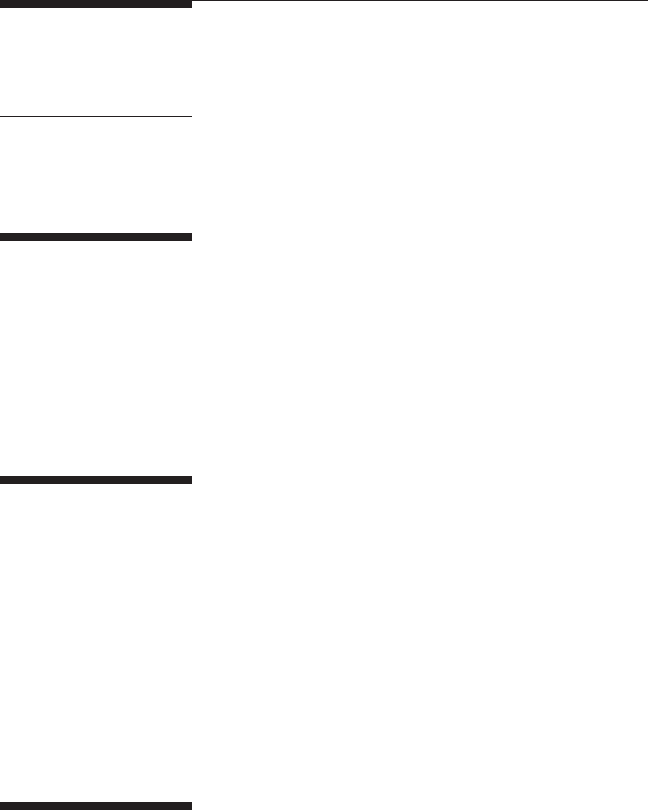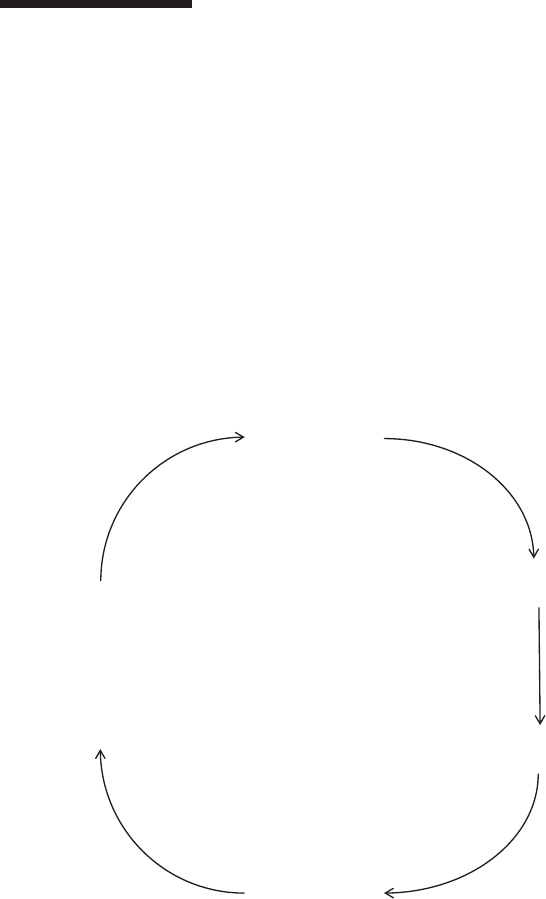
231
12
Creativity and the Monitoring
and Controlling Process
INTRODUCTION
e monitoring and controlling process involves collecting and assessing
information about the performance of a project and taking the necessary
corrective actions to improve that performance. It is closely linked with
another project management process, executing.
BENEFITS
ere are many benets attributed to the monitoring and controlling pro-
cess. It gives cost, schedule, and quality performance feedback on where the
project has been, is, and will be; it gives stakeholders a sense of condence
that project managers have a good idea about the state of a project at any
given time; it serves as an excellent way to communicate to all applicable
stakeholders; and it provides project managers with a way to respond more
eectively to circumstances, especially if something unexpected does arise.
CONSEQUENCES OF FAILURE
Failure to perform this process has several consequences. Project manag-
ers and other stakeholders will have little or no idea about the current state
of their projects or where they will end up. Due to lack of information
about status when something does go awry, they react by constantly put-
ting out res. Communication and collaboration challenges and failures

232 • Creative, Ecient, and Eective Project Management
are commonplace. Esprit de corps and morale oen deteriorate as people
start thinking the worst.
DELIVERABLES
e monitoring and closing process has several project management
deliverables (Figure12.1), including:
• Change request disposition
• Conguration management
• Corrective action
• Management reserve
• Procurements
• Quality control
• Replanning
• Risk response
• Status collection and forecasting
Preparation
Verification
and
Production
Concentration
Illumination
Incubation
- Change RequestDisposition
- Configuration Management
- Corrective Action
- Management Reserve
- Procurements
- Quality Control
- Replanning
- Risk response
- Status Collection and Forecasting
FIGURE 12.1
Monitoring and controlling process and deliverables.

Creativity and the Monitoring and Controlling Process • 233
IDEAL STATE
Ideally, project managers have a good communication management plan
in place that enables information to ow vertically (e.g., up and down the
chain of command) and horizontally (e.g., among peers, cost eectively).
All stakeholders identify and receive the information that they need, no
more and no less. ey have at their disposal the tools to provide status on
their activities and deliverables, and can pull any information satisfying
their needs or wants. All stakeholders follow the change and conguration
management processes and help evaluate the cost and schedule impacts of
a change. Everyone attends the necessary meetings and actively partici-
pates by sharing information and other insights. Ample time is available to
determine and take corrective action and, if necessary, perform replanning.
e reality, of course, is oen far from what is described above. Data
to generate information is frequently inaccurate and must be scrubbed
and veried. Some team members forget or do not want to provide sta-
tus. Some key stakeholders do not have the time or wherewithal to attend
meetings. Some changes are implemented, whether intentionally or inad-
vertently, aer bypassing the change and conguration management dis-
ciplines. Time and money are in short supply, which makes analysis and
decision making dicult and oen results in quick xes on symptoms
rather than focusing on the source of a problem or issue.
CONTEXT
ere are several contextual factors that project managers oen face
during the monitoring and control process. Here are just a few.
e monitoring and controlling process occurs simultaneously with the
executing process. is makes the relationship between the two processes
a very critical one to ensure that what is occurring in the executing process
is reected in what is produced during the monitoring and controlling
process.
As a result, the inputs and outputs of the monitoring and controlling
process must be accurate, timely, and useful to the stakeholders. Not an
easy responsibility to assume for any fast- moving, highly visible project.
In addition to the accuracy, timeliness, and usefulness of the output, the
234 • Creative, Ecient, and Eective Project Management
data obtained during this process must be scrubbed to ensure information
is not garbage. e larger the project, the greater the need to integrate the
two processes (executing and monitoring with controlling).
Also, eort is made, due to the dynamic environment of projects during
the executing process, to be proactive rather than reactive. Hence, there
exists a need to implement a disciplined approach to manage issues,
changes, and risks. Again, communication and information play key roles
as well as a need to adhere to management plans.
e entire monitoring and controlling process is viewed by some
stakeholders as necessary, while others might see it as red tape or bureau-
cratic. Depending on the degree of power that project managers possess,
this process can operate smoothly or it can be a major headache. If the
latter, it can require some creative thinking on how to make the process
more ecient, eective, and value- added for all key stakeholders.
CHALLENGES AND CONSTRAINTS
Perhaps the two biggest challenges and constraints that aect this process
are communication and information. Both, naturally, are tightly linked;
the quality of one aects that of the other.
Communication becomes a challenge and constraint because eec-
tive communication is dicult to implement. Stakeholders have dierent
styles and needs, and the larger the project, the more dicult it becomes
to satisfy the latter. Some people prefer the personal touch when receiving
communications while others want to communicate only through email.
Some people prefer group sessions while others want a regularly scheduled
one-on-one session. Some people want to communicate constantly while
others only do so when an issue or problem needs attention.
Information is the other challenge and constraint. Too much infor-
mation is just as problematic as too little. A balance is needed to ensure
eective communications. People vary, too, on how information is pre-
sented and delivered. Some people want summary information while
others want detail. Some people want it graphically while others desire
itin narrative form. Some people want it in hard copy while others want
it electronically.
Some common creative challenges and constraints confronting this
process are shown in Table12.1.

Creativity and the Monitoring and Controlling Process • 235
TABLE12.1
Monitoring and Controlling Process and Challenges and Constraints
Challenge and Constraint Example
Craving for predictability Relentlessly pursuing facts and data when more
than enough is already available
Dominance of brain thinking Weaving detail analysis with an overall assessment
of aproject’s performance
Faster, better, cheaper philosophy Encouraging people to produce a deliverable replete
with defects to meet a key milestone date
Fear Being afraid of reprisals for coming up with
asolution to a technical problem that will upset
certain stakeholders
Focus on the past or future, not
the present
Allowing a detected defect to pass through
inspection in order to maintain schedule
performance
Groupthink Allowing team members to suppress individual
suggestions for improving the performance of
aproject
Inability to adapt Adhering to a communications plan that is
ineective
Lack of data and information Not having access to information and data to come
up with solutions to quality problems
Lack of sharing Failure of team members to impart knowledge and
experience to help resolve slides in the current
schedule
Lack of tools No soware to conduct analysis to determine the
cause of a problem
Leaping to judgment Asking for additional funds from the management
reserve before determining if other alternatives
exist
Management’s lack of
responsiveness
Awaiting an important approval by key stakeholders
to pull money from the management reserve
Methodism Paying more attention to following a process
described in a management plan than the resulting
quality of the output
Mores, beliefs, values Following traditional practices for raising issues to
management, regardless of priority
Overemphasis on by-the-book
philosophy
Adhering strictly to a process described in
amanagement plan
Poor communications Failing to inform stakeholders of a key decision that
could aect the quality of deliverables
Poor coordination Failing to include other key stakeholders in
achange management meeting
(Continued)
..................Content has been hidden....................
You can't read the all page of ebook, please click here login for view all page.
